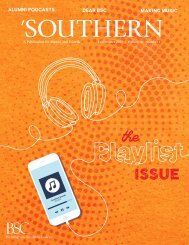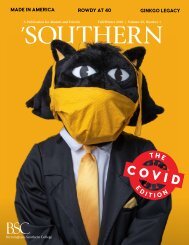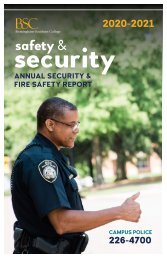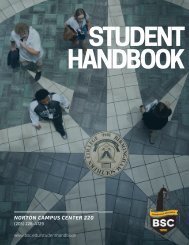Southern Fall/Winter 2022
A Publication for Alumni and Friends
A Publication for Alumni and Friends
Create successful ePaper yourself
Turn your PDF publications into a flip-book with our unique Google optimized e-Paper software.
TENACITY<br />
Forrest Boughner ’09 says that he first started out in<br />
track and cross country at his mother’s insistence.<br />
“Basketball was my thing,” he says, “but a week before<br />
high school started, my mom said, ‘You’re going to try out<br />
for the cross-country team, and you have to attend at least<br />
three practices before you quit.”<br />
Countless practices later, Boughner hasn’t quit yet. Today,<br />
he works as a running coach and trail guide specializing<br />
in mountain running in Missoula, Mont. He founded<br />
Alpine Running Guides in 2018 and has also worked as<br />
the operations manager at Five Valleys Land Trust. His<br />
goal is to expose more runners to the joy of running<br />
trails and to foster an appreciation for wilderness and<br />
ecological responsibility. Collaborating with several other<br />
guides including his wife Sara, Boughner’s company offers<br />
personalized coaching and guided trail-running trips for<br />
groups of 10 to 14 people.<br />
“Growing up in Flagstaff, Ariz. at the base of a 12,000-<br />
foot mountain, trail hiking and running have always been a<br />
part of my life,” says Boughner. “I also really like exploring<br />
and finding new places.”<br />
In 2013 and 2014, Boughner and his then-fiancée<br />
Sara hiked the Continental Divide National Scenic Trail,<br />
stretching from Mexico to Canada, through New Mexico,<br />
Colorado, Wyoming, and a small part of Idaho and Montana.<br />
The trek was a total of five months of hiking.<br />
“One aspect of a long trip like that is, you have periods of<br />
ups and downs. There are days where you’re not going to feel<br />
good,” says Boughner. “You’re exhausted and you’re beat<br />
down, and your feet are hurting, and you wonder, ‘Why am I doing this?’”<br />
He says that the mutual support and common shared goal is what<br />
made the trip possible.<br />
“Setting strong goals helps. We wanted to complete our goal more<br />
than we wanted to quit. We just hoped that we both weren’t down on<br />
the same day. We were able to fully trust the other person to help when<br />
things got tough.”<br />
“Anyway, you’re out in the middle of the woods,” he continues, “so if<br />
you don’t want to do it anymore, you have to hike out, so you have to<br />
keep hiking, either way. Your only option is to keep going.”<br />
Partway through the trip, the two faced an enormous challenge when<br />
they both became sick with giardia. While his wife had a milder case,<br />
Boughner did not realize he was sick with the same disease until weeks<br />
later, after experiencing more unusual symptoms of increasing nausea<br />
and racing heart rate. One day, he passed out while hiking. Emergency<br />
room doctors warned Boughner that he should stay off the trails for the<br />
rest of the season.<br />
“That was a big challenge for our partnership,” admits Boughner. “Sara<br />
really wanted to continue — she was feeling better — but she was also<br />
worried about me. I hated to keep her from finishing. That was a big thing<br />
we had to work through.”<br />
“...so if you don’t want to do it<br />
anymore, you have to hike out, so<br />
you have to keep hiking, either way.<br />
Your only option is to keep going.”<br />
The two returned to the trail the following summer, picking up where<br />
they had left off.<br />
Boughner says that one of the toughest aspects of being a trail guide is<br />
also the most rewarding.<br />
“I take a lot of people out on trails that not many people go on. Sometimes<br />
I’m guiding people who have never trail-run before, or who have never been<br />
up a mountain before, or they may be terrified of bears, for example. I’m<br />
trying to figure out what each individual person in a group is worried about,<br />
or what their physical limitations are, and trying to blend that all in one day,<br />
and make sure people still come out with a good experience.”<br />
However, his favorite part of the job is being able to help others overcome<br />
obstacles and stretch themselves to accomplish goals they might not have<br />
otherwise been able to do.<br />
“As a coach, I get to be a part of people’s lives during training — their<br />
successes and failures; whether they are struggling with family stuff or work<br />
stress; and no matter what, they still got out the door and ran. Then, on<br />
race day, especially if they’re running a 50-mile or 100-mile race, it’s this<br />
huge emotional event. Reaching the finish line of something that big, a goal<br />
they’ve had for a long time, is very emotional, especially when it’s been a<br />
challenging training process. I love seeing those tears of happiness. I get to<br />
see all that hard work and persistence pay off, and that’s fantastic.”<br />
FALL/WINTER <strong>2022</strong> / 35



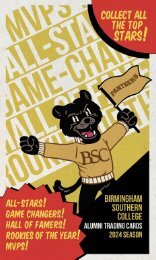
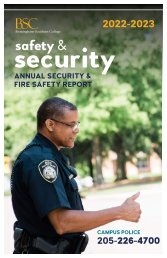

![2023-2024 BSC Catalog Updated_UG ONLY_FINAL[82]](https://img.yumpu.com/68414854/1/178x260/2023-2024-bsc-catalog-updated-ug-only-final82.jpg?quality=85)



